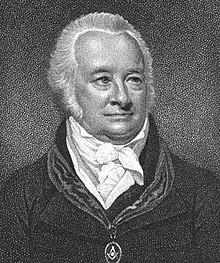William Preston (Freemason)
Meanwhile, Preston senior's health and fortunes declined, due to bad investments and supporting the wrong side in the 1745 rebellion.
Here he would spend his professional life as an editor, earning the respect of writers such as David Hume and Edward Gibbon.
[2] Shortly after Preston's arrival in London, a group of Edinburgh Freemasons living in the English capital decided to form themselves into a lodge.
Interviewing where he could, and entering into an extensive correspondence with Freemasons in Britain and overseas, he built a vast storehouse of masonic knowledge, which he applied initially to explaining and organising the lectures attached to the three degrees of Freemasonry.
He met with friends once or twice a week to test and refine his presentation, and on 21 May 1772 he organised a Gala at the Crown and Anchor in the Strand at his own considerable expense, to introduce the Grand Officers and other prominent masons to his system.
The success of his oration on that day led to the publication, later that year, of his Illustrations of Masonry, which ran to twelve English editions in the authors lifetime, as well as being translated into other languages.
Antiquity was suffering from declining membership, and these two men conceived the idea of reviving their lodge by recruiting Preston.
He complained that the younger masons who now flocked to the lodge were all Preston's creatures, which had enabled him to stay in the chair for three and a half years.
[4] On 27 December 1777, some members of the Lodge of Antiquity, including Preston, returned from church wearing their masonic regalia.
In May 1789 the dispute was resolved, Preston, after an apology, was welcomed back to his Masonic Honours at a dinner, and the two-halves of the Lodge of Antiquity were re-united in 1790.
About the time of his re-admission to the Moderns, he founded the Order (or Grand Chapter) of Harodim, which was a vehicle for his own ideas about masonry as expressed in his lectures.
His major masonic legacy must be considered to be his Illustrations of Masonry, which continued to new editions after his death, after a long illness, in 1818.
[8] Preston's lasting impact is in drawing the perception of Freemasonry away from the bar and the dining table, and giving it a more cerebral appeal.

